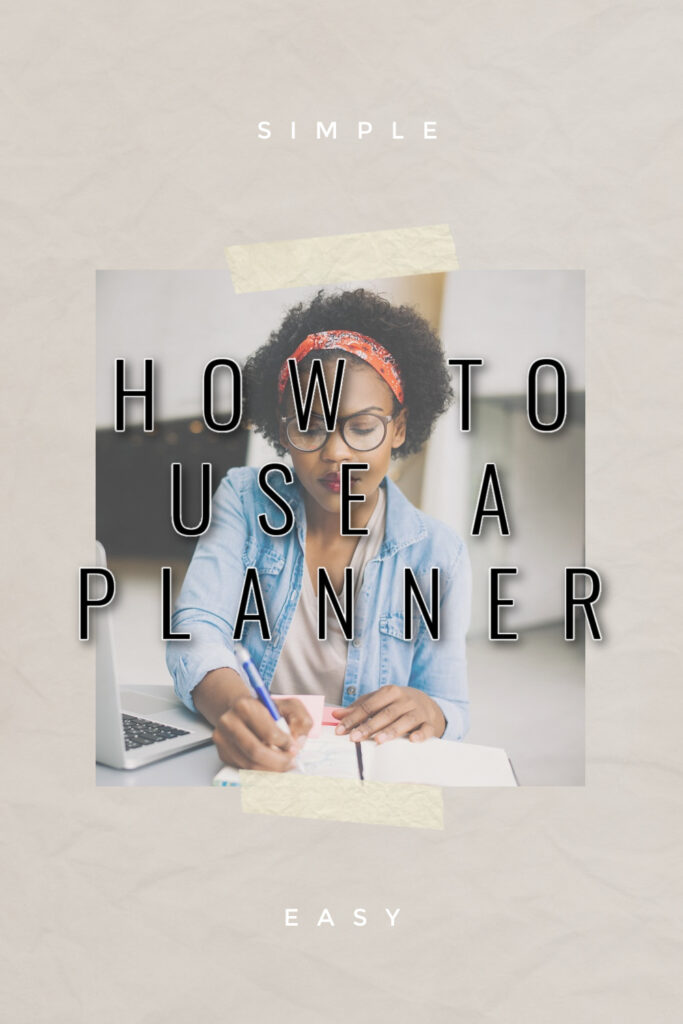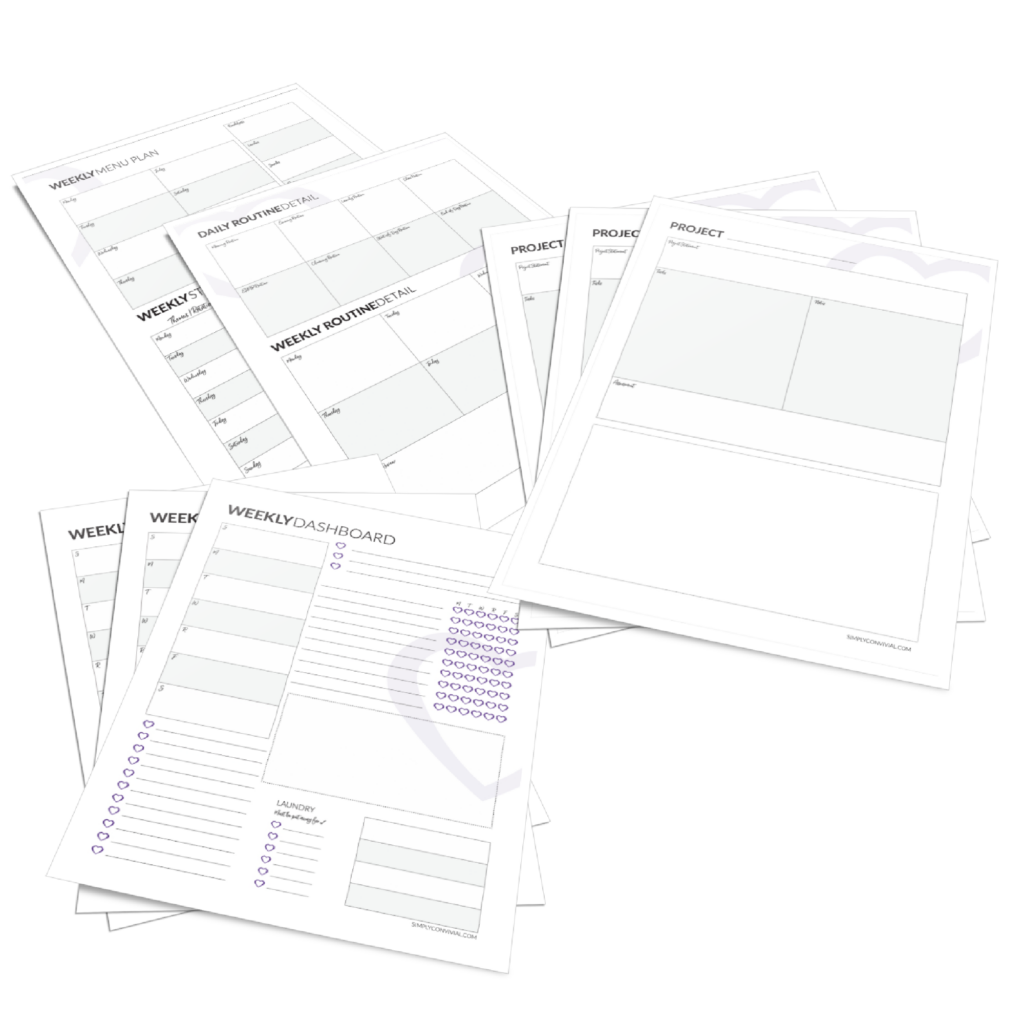How to use a planner as a busy mom.
Now is the promising time of year. The school supplies are in the story, the plans are on paper and not yet proven untenable, and the hope of a workable planner springs eternal.
We’re fine with putting in the time to set up a planner. We’ll buy the notebook, fill it out, decorate it with some stickers maybe, and then – hope for the best.
What comes next?
Real life begins and our imagined version of our life and our real life never really meet.
We quit using it because we find it doesn’t exactly match up. Our life doesn’t follow our well-laid plans, so we stop planning. We stop thinking about it. We just fly by the seat of our pants. Putting out emergency life fires takes up all our time.
We want to use a planner…
Maybe we’re committed this time. We want to be dedicated to really doing it. We want this one to work this time. We want these hours spent setting it up to not go to waste.
Only to find that we don’t know what to do with that planner when it doesn’t match up to our real life. Our day, our week, didn’t go as we predicted. Now what? Maybe planning is hopeless.
We begin not just forgetting to use our planner, but we wind up avoiding our planner because every time we look at we’re confronted with how far short our actual output comes from the desired output.
No matter how hard we try to be realistic, we never do get everything checked off.
Whether it’s forgetfulness, franticness, or avoidance, once we stop using our planner, it’s even harder to come back to it. Follow-through takes time and attention, and the longer we go without follow-through, the harder it becomes.
Your mind is a bad planner
Having a working planner is worth the effort to learn how to use it effectively. We can filter all the ideas and obligations that pop into our heads. We can focus our efforts and attention by working things out in writing. With that plan in writing, we don’t have to rely on our memory.
Our memories make bad planners.
With a reasonable planner we can manage our expectations and our attitude because our responsibilities are in front of our face for us to see, remember, and evaluate, not just rattling around in our head.
When our hopes are swirling in our head, we’re more vulnerable to our default responses. We rely on our emotions to filter and motivate. So we become unpredictable, unmotivated, and volatile – because that’s the nature of our default emotions.
Spending the time to write a plan, then to look at it, is one way of “preaching to yourself.” We can’t live by default responses and impulses. We have to use our brain to think and problem solve, not hold information and details.
Make a plan on paper
We right things down so we can think about them more clearly and respond more appropriately to the actual situation at hand, even when that situation doesn’t go the way we expected.
When we’re working from a regular rhythm, we’re not operating at the edge of our emotional resilience. Without a plan, we’re using up too much of our bandwidth thinking the same things over and over again so we don’t lose them – then we don’t have the mental and emotional resources to properly process and respond to the real life in front of us.
Free Planner Templates
Avoid perfectionism
Perfectionism prevents us from planning well and keeping up with our plans. We want our collected notes to be a pristine artifact, a monument to our aesthetic, with each and every task checked off each and every day. We want to be positive we’ve chosen the best planner and completely, fully filled it out before our starting date. We want it to always completely reflect the situation.
Perfectionists want all or nothing, they go through boom and bust cycles, and while seeking perfection often end in paralyzation.
The goal isn’t a perfect and pristine planner and a planning system with habits that allows us to control our lives so our plans always work out.
Your planner is a tool.
When tools are used, they get dull, dirty. They deteriorate. Tools need upkeep. There’s no planner you can choose or habit you can install that will undo or prevent that reality. Instead, we work with reality and acknowledge that our planner is a working document, never finalized, never perfect.
A planner is a filtering tool. Filters get clogged and become useless if they aren’t cleaned out regularly. So it is with planners.
A weekly review is the time that we clean out our filter-planners. It is when we wash off the accumulated dirt, sharpen the blade, build it back again.
Schedule a weekly review.
Usually the only people talking about weekly reviews are business types. David Allen in Getting Things Done says a weekly review should be about 2 hours at the end of the work day on Friday.
And every mother said: “Ain’t nobody got time for that.”
No kidding. But that doesn’t mean we ought to write it off completely.
I’ve been teaching women, homeschooling moms, working moms, housewives in the retirement stage, to do weekly reviews for over 5 years now. It’s one piece of many in our Simplified Organization program.
Although it’s one piece of many, it’s the piece that women report made the biggest difference. Those who focused on figuring out and sticking with a weekly review are the women who reported the most progress overall in other areas as well, the ones who grew their capacity and bandwidth, the ones who developed their own strategies for rejecting stress by repeating truth.
I am convinced the weekly review is worth zooming in on. It is the linchpin piece, the planning piece most of us are missing that prevents our plan from actually working.
How to use a planner effectively
We know we need to look at our plan for it to work. But we also need to work from the plan. Yet life won’t go as planned – then what? How to we recover, recoup after the unexpected? It happens in the weekly review.
How to we adapt our plans and flex with life? How to we stay agile and attentive to the people in our lives, as we should, and not get rigid and controlling with our plan? This is a skill we learn by circling back around to learn and adapt each week.
There’s no one piece of information or knowledge that, once gained, will make us know exactly what to do when.
We have to jump in, not wait for everything to be outlined totally and completely.
Know your plan. Work your plan.
A better plan happens when we start where we are, with what we have, and learn and grow and adapt and develop as we practice. Jump in with doing. Learn by doing, then pause weekly to incorporate what you’ve learned into your next plan.
A weekly review makes the space for that process to happen. It doesn’t take two hours a week. It can take about 30 minutes, if you stay focused.
I know that’s a big if.
Mom’s Weekly Review Masterclass
The weekly review is a time set aside to remind yourself to what you have on your plate and choose your commitments so you can stay organized.
You take some time and look at your calendar, make fresh to-do lists, decide what your biggest responsibilities are this week and then make sure those stay in front of your face so they can get done.
Once we spend some time setting up our planner, the next step is to actually practice how to use a planner. We can’t stay organized with a planner unless we look at it to keep our systems on track. A weekly review is my top tip for planning and organizing real life.
That’s why I put together the Mom’s Weekly Review Masterclass. You can take the class as a stand-alone, lifetime-access class.






